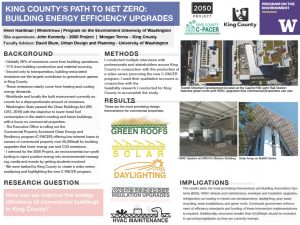King County’s Path to Net Zero: Building Energy Efficiency Upgrades
Globally 28% of emissions come from building operations and 11% from building construction and material sourcing. Second only to transportation, building-associated emissions are the largest contributor to greenhouse gasses in King County. Worldwide and locally the built environment currently accounts for a disproportionate amount of emissions. Washington State passed the Clean Buildings Act (HB 1257, 2019) with the objective to lower fossil fuel consumption in the state’s existing and future buildings, with a focus on commercial properties. The Executive Office is rolling out the Commercial Property Accessed Clean Energy and Resiliency program to offer low-interest loans to owners of commercial property over 50,000sqft for building upgrades that lower energy use and CO2 emissions. The purpose of this study was to identify and market feasible solutions and building upgrades to be implemented on structures and properties in King County. I conducted multiple interviews with professionals and stakeholders across King County in conjunction with the production of a video series promoting the new CPACER program. I used their qualitative accounts in conjunction with the feasibility research I conducted for King County to accomplish the study. The results state the most promising interventions are Building Automation Systems (BAS), HVAC rehauls and maintenance, envelope and insulation upgrades, refrigeration as heating in mixed-use developments, daylighting, gray water recycling, solar installations, and green roofs. Continued government enforcement of efficiency standards and funding of these intervention implementations is required. Additionally, structures smaller than 50,000sqft should be included in upcoming legislation as they are currently exempt.
